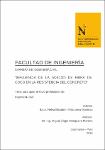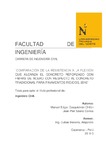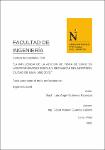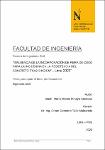Mostrar el registro sencillo del ítem
Influencia de la adición de fibra de coco en la resistencia del concreto
| dc.contributor.advisor | Mosqueira Moreno, Miguel Ángel | |
| dc.contributor.author | Villanueva Monteza, Nelva Elizabeth | |
| dc.date.accessioned | 2017-06-19T16:19:31Z | |
| dc.date.available | 2017-06-19T16:19:31Z | |
| dc.date.issued | 2016-10-25 | |
| dc.identifier.citation | Villanueva, N. E. (2016). Influencia de la adición de fibra de coco en la resistencia del concreto (Tesis de licenciatura). Repositorio de la Universidad Privada del Norte. Recuperado de https://hdl.handle.net/11537/10491 | es_PE |
| dc.identifier.other | 624 VILL 2016 | es_PE |
| dc.identifier.uri | https://hdl.handle.net/11537/10491 | |
| dc.description.abstract | RESUMEN La tesis estudia la influencia que presenta el concreto con respecto a la resistencia mecánica, al adicionarle diferentes porcentajes de fibra, para dicho estudio se realizó diferentes ensayos a los agregados, tanto al agregado grueso como al fino, dichos agregados fueron extraídos del río Mashcón, los ensayos que se realizaron fueron: ensayo granulométrico, ensayo de contenido de humedad, ensayo de peso específico y absorción, peso unitario, ensayo de material más fino que pasa por la malla N° 200, ensayo de abrasión; dichos ensayos fueron realizados para determinar las propiedades de los agregados para así poder realizar el diseño de mezcla por el método del ACI-211 y el método del módulo de finura de la combinación de agregados, eligiendo como nuestro diseño a utilizar el segundo método mencionado. La fibra de coco fue traída de la provincia de Jaén, ya que en esta ciudad el fruto es comercializado pelado, por ende la fibra de coco utilizada para esta investigación fue extraída manualmente. Los porcentajes de fibra utilizados fueron del 0.5%, 1.0%, 1.5% y 2.0% con una longitud de 2.5 cm, los porcentajes se incorporaron a la mezcla en relación del agregado fino. Se elaboraron 45 probetas cilíndricas y 45 especímenes de concreto para ser ensayadas a compresión y a flexión respectivamente. Finalmente se concluyó que al adicionar fibra de coco en 0.50%, 1.00%, 1.50% y 2.00% a las probetas de concreto, los valores de resistencia a compresión en porcentaje a los 28 días de edad son de 95.60%, 98.39%, 76.37% y 65. 73%, reportándose así una disminución en la resistencia al adicionarle fibra de coco, en cambio al utilizar los mismos porcentajes en los especímenes de concreto los valores obtenidos en porcentaje a los 28 días de edad son de 127.53%, 129.85%, 132.84% y 140. 88% aumentando así la resistencia a la flexión en un 30%. | es_PE |
| dc.description.abstract | ABSTRACT This thesis researches into the mechanical resistance that concrete can perform when added different percentages of fiber. Granulometric trials, levels of humidity, specific weight, levels of absorption, unit weight and finest material, to go through wire mesh # 200, and abrasion testing were performed to coarse and fine aggregates to determine their properties and to be able to determine the final mix design by using the “ACI -211” and the fineness modulus methods. This latest method was the one selected for our final design. All aggregates were extracted from “Mashcon” river. Hand - peeled coconut fiber was brought from the province of Jaen in Peru. It is important to remark that this fiber was peeled out by hand. Fiber percentages used were of five tenths per hundred (0.50%), one per hundred (1.00%), one and a five tenths per hundred (1.50%), and two per hundred (2.00%) with a length of 2.5 centimeters. Every percentage of fiber was incorporated to the mixture in relation to fine aggregates.Forty-five (45) measuring cylinders and forty-five (45) samples of concrete were elaborated to carry out both compression and bending tests. It was concluded that a reduction in resistance is obtained by adding coconut fiber in fifty tenths per hundred (0.50%), one per hundred (1.00%), one and five tenths per hundred (1.50%) and two per hundred (2.00%) to the measuring cylinders, resistance values are of: ninety-five and six tenths parts per hundred (95.60%), ninety-eight and thirty-nine hundredths parts per hundred (98.39%), seventy-six and thirty-seven hundredths per hundred (76.37%) and sixty-five and seventy-three hundredths per hundred (65.73%).By contrast, when the same percentages are used in twenty-eight (28) days-concrete samples, the resultant values are of: one hundred twenty-three and fifty-three hundredths per hundred (123.53%), one hundred twenty-nine and eighty-five hundredths per hundred (129.85%), one hundred thirty-two and eighty-four hundredths per hundred (132.84%), and one hundred forty and eighty-eight hundredths per hundred (140.88%) evidencing an increase in bending resistance up to thirty per hundred (30%). | es_PE |
| dc.description.uri | Tesis | es_PE |
| dc.format | application/pdf | es_PE |
| dc.format | application/msword | es_PE |
| dc.language.iso | spa | es_PE |
| dc.publisher | Universidad Privada del Norte | es_PE |
| dc.rights | info:eu-repo/semantics/openAccess | es_PE |
| dc.rights | Atribución-NoComercial-CompartirIgual 3.0 Estados Unidos de América | es_PE |
| dc.rights.uri | https://creativecommons.org/licenses/by-nc-sa/3.0/us/ | * |
| dc.source | Universidad Privada del Norte | es_PE |
| dc.source | Repositorio Institucional - UPN | es_PE |
| dc.subject | Resistencia de materiales | es_PE |
| dc.subject | Concreto | es_PE |
| dc.subject | Resistencia a la compresión | es_PE |
| dc.title | Influencia de la adición de fibra de coco en la resistencia del concreto | es_PE |
| dc.type | info:eu-repo/semantics/bachelorThesis | es_PE |
| thesis.degree.grantor | Universidad Privada del Norte. Facultad de Ingeniería | es_PE |
| thesis.degree.level | Título Profesional | es_PE |
| thesis.degree.discipline | Ingeniería Civil | es_PE |
| thesis.degree.name | Ingeniero Civil | es_PE |
| dc.publisher.country | PE | es_PE |
| dc.subject.ocde | https://purl.org/pe-repo/ocde/ford#2.01.01 | es_PE |
| thesis.degree.program | Pregrado | es_PE |
| dc.description.sede | Cajamarca | es_PE |
| renati.advisor.dni | 26733060 | |
| renati.advisor.orcid | https://orcid.org/0000-0003-2668-4909 | es_PE |
| renati.author.dni | 46035243 | |
| renati.discipline | 732016 | es_PE |
| renati.juror | Aguilar Aliaga, Orlando | |
| renati.juror | Ignacio Malca, Jhonny Alejandro | |
| renati.juror | Vásquez Sevillano, José Miguel Ángel | |
| renati.level | https://purl.org/pe-repo/renati/level#tituloProfesional | es_PE |
| renati.type | https://purl.org/pe-repo/renati/type#tesis | es_PE |
Ficheros en el ítem
Este ítem aparece en la(s) siguiente(s) colección(ones)
-
Tesis [1436]








